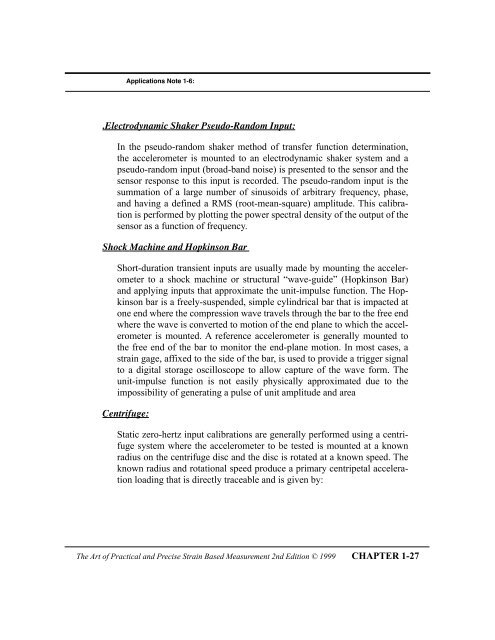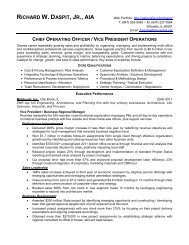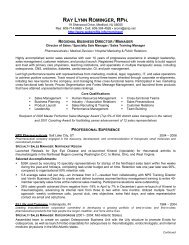The Art of Practical and Precise Strain Based ... - Webprofile.info
The Art of Practical and Precise Strain Based ... - Webprofile.info
The Art of Practical and Precise Strain Based ... - Webprofile.info
- No tags were found...
Create successful ePaper yourself
Turn your PDF publications into a flip-book with our unique Google optimized e-Paper software.
Applications Note 1-6:.Electrodynamic Shaker Pseudo-R<strong>and</strong>om Input:In the pseudo-r<strong>and</strong>om shaker method <strong>of</strong> transfer function determination,the accelerometer is mounted to an electrodynamic shaker system <strong>and</strong> apseudo-r<strong>and</strong>om input (broad-b<strong>and</strong> noise) is presented to the sensor <strong>and</strong> thesensor response to this input is recorded. <strong>The</strong> pseudo-r<strong>and</strong>om input is thesummation <strong>of</strong> a large number <strong>of</strong> sinusoids <strong>of</strong> arbitrary frequency, phase,<strong>and</strong> having a defined a RMS (root-mean-square) amplitude. This calibrationis performed by plotting the power spectral density <strong>of</strong> the output <strong>of</strong> thesensor as a function <strong>of</strong> frequency.Shock Machine <strong>and</strong> Hopkinson BarShort-duration transient inputs are usually made by mounting the accelerometerto a shock machine or structural Òwave-guideÓ (Hopkinson Bar)<strong>and</strong> applying inputs that approximate the unit-impulse function. <strong>The</strong> Hopkinsonbar is a freely-suspended, simple cylindrical bar that is impacted atone end where the compression wave travels through the bar to the free endwhere the wave is converted to motion <strong>of</strong> the end plane to which the accelerometeris mounted. A reference accelerometer is generally mounted tothe free end <strong>of</strong> the bar to monitor the end-plane motion. In most cases, astrain gage, affixed to the side <strong>of</strong> the bar, is used to provide a trigger signalto a digital storage oscilloscope to allow capture <strong>of</strong> the wave form. <strong>The</strong>unit-impulse function is not easily physically approximated due to theimpossibility <strong>of</strong> generating a pulse <strong>of</strong> unit amplitude <strong>and</strong> areaCentrifuge:Static zero-hertz input calibrations are generally performed using a centrifugesystem where the accelerometer to be tested is mounted at a knownradius on the centrifuge disc <strong>and</strong> the disc is rotated at a known speed. <strong>The</strong>known radius <strong>and</strong> rotational speed produce a primary centripetal accelerationloading that is directly traceable <strong>and</strong> is given by:<strong>The</strong> <strong>Art</strong> <strong>of</strong> <strong>Practical</strong> <strong>and</strong> <strong>Precise</strong> <strong>Strain</strong> <strong>Based</strong> Measurement 2nd Edition © 1999 CHAPTER 1-27
















